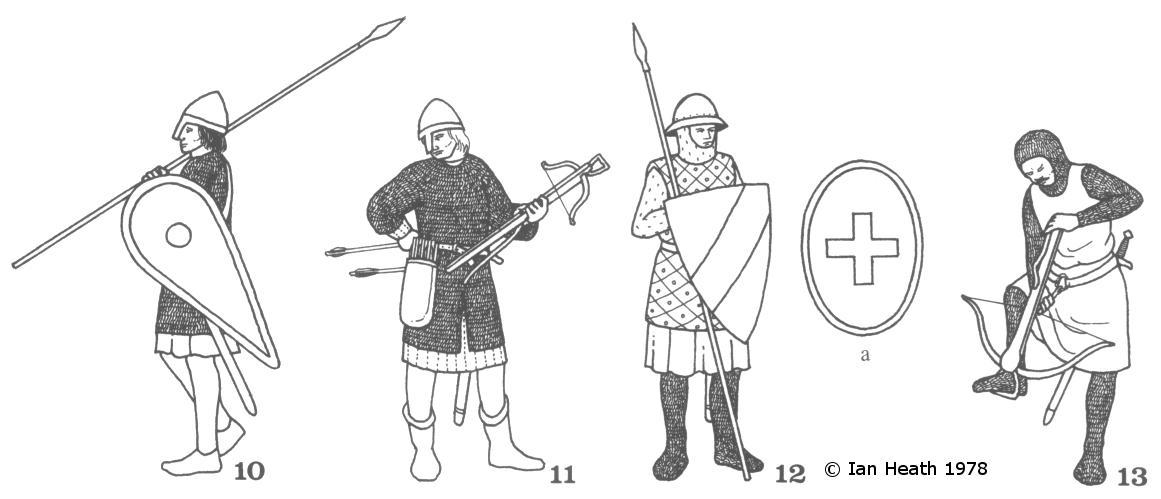
Create an Amazon Business Account
FRANKISH INFANTRYMEN
An extract from Armies and Enemies of the Crusades 1096-1291by Ian Heath
 | |||
| [Based on Histoire d’Outremer BnF Fr 9084] | [Based on Pierpont Morgan Library. Manuscript. M.969, fol. 150r] | ||

 | |||
| [Based on Histoire d’Outremer BnF Fr 9084] | [Based on Pierpont Morgan Library. Manuscript. M.969, fol. 150r] | ||
10, 11, 12 & 13. FRANKISH INFANTRYMEN
Infantry in the crusader states ranged from pilgrims armed with no more than spear or bow (see 1 and 2), through to well-armed and armoured mercenaries and feudal retainers, the latter elements comprising the largest percentage of foot-soldiers in most armies, armed chiefly with spear, bow or crossbow though some may have been equipped with both spear and how. The Anonymi Gesta Francorum records crossbows in use as early as the First Crusade, as does Anna Comnena, and certainly by the middle to late-12th century the crossbow was the weapon par excellence of the Frankish infantryman.
10 and 11 are based on descriptions of the 12th century. Beha ed-Din, writing of Frankish infantry at Arsouf in 1191, describes how they were ‘clothed in a kind of thick felt, and mail corselets as ample as they were strong, which protected them against arrows. I have seen men with up to 10 arrows stuck in their bodies marching no less easily for that.’ Ambroise, describing the same battle, likewise records that the infantry were ‘armed quite well according to the custom of foot-soldiers, (with) head protected by an iron cover, (and) a hauberk and a linen tunic padded many times and difficult to penetrate, ingeniously worked with a needle and consequently called in the vernacular a Pourpoint.’ Such quilted corselets, though known in Europe for several centuries, only came into widespread use during the Crusades through contact with the Moslems, amongst whom quilted armour was a standard form of body-defence (see note 35-38); the Moslems called it al-Qutun, literally ‘cotton’, a term which the Franks soon corrupted to Aketon (see figures 26-28 in ‘Armies of Feudal Europe’). ‘Gambeson’ was an alternative term that first appeared c. 1160, possibly differing from the aketon in having sleeves. Basically all such armour consisted of a leather, linen or woollen tunic padded with wool, cotton and old rags and quilted either vertically or diagonally.
12, based on illustrations in an Acre ms. of c. 1280, gives a general idea of the appearance of such armour, in this instance 2 such corselets being worn one over the other (possibly aketon over gambeson). Figure 13, similarly dating to the late-l3th century, substitutes mail corselet and surcoat. Both wear mail chausses in addition.
Unlike spearmen, crossbowmen and archers apparently carried no shields. Although most shields were like those of 10 and 12 it should be noted that some of the mss. illuminated in Acre as late as 1290-1291 show circular shields in use amongst Frankish infantry, one ms. of 1287 even depicting oval shields such as 12a.
The clothes of Franks in Outremer were of cotton, wool, linen and silk. Colours were generally bright, principally red, green and yellow, and also black, those of the upper classes often being richly embroidered in gold and coloured thread. The Franks were generally cleanshaven by the mid-12th century, one contemporary pilgrim noting that of all the peoples of Outremer they ‘are the only one . . . who shave the beard.’
For other infantrymen of this era see ‘Armies of Feudal Europe’. In addition, in crusading armies many knights were frequently reduced to the role of infantry by the loss of their horses.